
The number of Americans living in community associations has grown exponentially over the last 40 to 50 years, from 10,000 communities in the 1970s to well over 300,000 as of 2016. While those figures also include condominium communities and co-operatives, homeowners associations (or HOAs) account for just over half of those communities. While some people love that their HOA mows the lawn, manages neighborly disputes, organizes social events, and provides desirable amenities, others bemoan their exorbitant fees, poor management, and their long list of rules. An HOA community can be an oasis to some, while others can’t wait to move out. We surveyed over 700 people who currently live in an HOA community to learn more about the HOA lifestyle.
Making the move
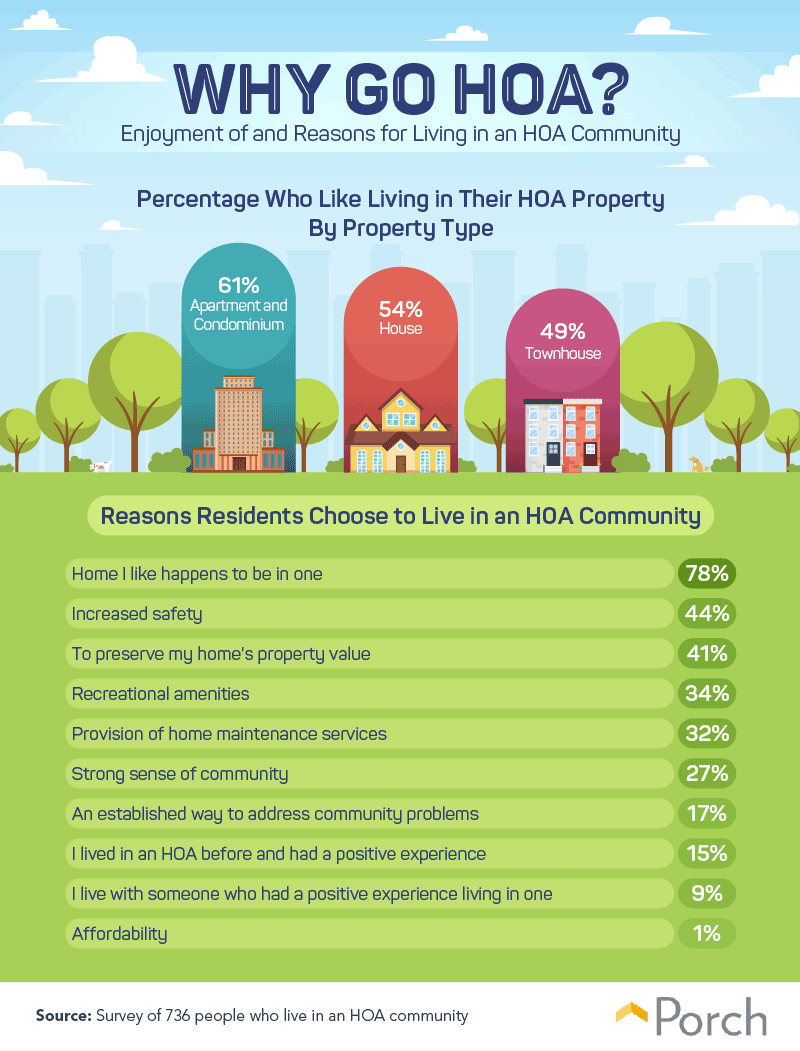 To HOA or not to HOA? If you’re looking for a condo or apartment, the odds of experiencing a harmonious relationship with your HOA are high. Just over 60 percent of respondents living in this type of property said they were happy with their living situation, compared to 54 percent of homeowners and 49 percent of townhouse owners. Most people who ended up living in a complex with an HOA hadn’t specifically sought it out: 78 percent said the property they liked just so happened to be a part of one. Another 44 percent said they enjoyed the increased level of safety it provided, and 41 percent thought joining one would preserve their home’s value. The latter group may indeed be onto something: One recent study revealed homes that were part of an HOA sold for an average of 4 percent more than those that were independent. HOAs typically run a tight ship when it comes to maintaining cleanliness and home quality, which can lead to more desirable valuations.
To HOA or not to HOA? If you’re looking for a condo or apartment, the odds of experiencing a harmonious relationship with your HOA are high. Just over 60 percent of respondents living in this type of property said they were happy with their living situation, compared to 54 percent of homeowners and 49 percent of townhouse owners. Most people who ended up living in a complex with an HOA hadn’t specifically sought it out: 78 percent said the property they liked just so happened to be a part of one. Another 44 percent said they enjoyed the increased level of safety it provided, and 41 percent thought joining one would preserve their home’s value. The latter group may indeed be onto something: One recent study revealed homes that were part of an HOA sold for an average of 4 percent more than those that were independent. HOAs typically run a tight ship when it comes to maintaining cleanliness and home quality, which can lead to more desirable valuations.
Feelings about fees
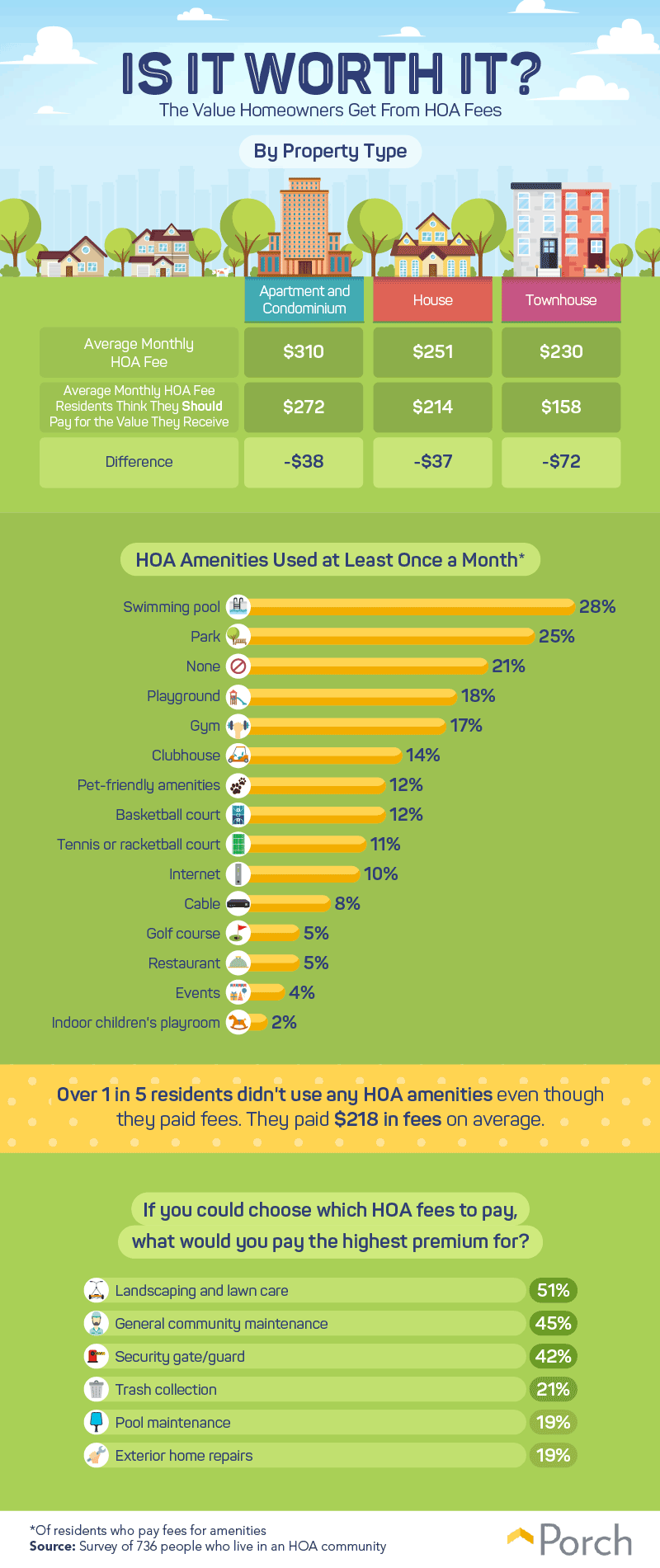 No matter how satisfied people were with their HOA experiences, everyone felt they were paying a little too much every month for the services they received. Townhouse dwellers thought they should pay an average of $72 less per month, while house and condo owners reported wanting to pay closer to $214 and $272 versus $251 and $310, respectively. Those fees are collected for a reason, though. When searching for a home, there is no shortage of amenities you can add to your “want” list, and an HOA can make those a reality by collecting funds each month. It’s all about finding an association that uses its dues wisely so you get the most bang for your buck. The most used amenities were swimming pools, with 28 percent of residents (who paid for that amenity as a part of their fee) saying they used theirs at least once a month. A quarter made use of the park in their complex each month, but the third most popular response was using no amenities at all—even though they were required to pay for them. If the scales were to be rebalanced, 51 percent said they would pay the highest premium for landscaping, and 45 percent would like to make a more weighted contribution to general community maintenance.
No matter how satisfied people were with their HOA experiences, everyone felt they were paying a little too much every month for the services they received. Townhouse dwellers thought they should pay an average of $72 less per month, while house and condo owners reported wanting to pay closer to $214 and $272 versus $251 and $310, respectively. Those fees are collected for a reason, though. When searching for a home, there is no shortage of amenities you can add to your “want” list, and an HOA can make those a reality by collecting funds each month. It’s all about finding an association that uses its dues wisely so you get the most bang for your buck. The most used amenities were swimming pools, with 28 percent of residents (who paid for that amenity as a part of their fee) saying they used theirs at least once a month. A quarter made use of the park in their complex each month, but the third most popular response was using no amenities at all—even though they were required to pay for them. If the scales were to be rebalanced, 51 percent said they would pay the highest premium for landscaping, and 45 percent would like to make a more weighted contribution to general community maintenance.
Rule-breaking residents
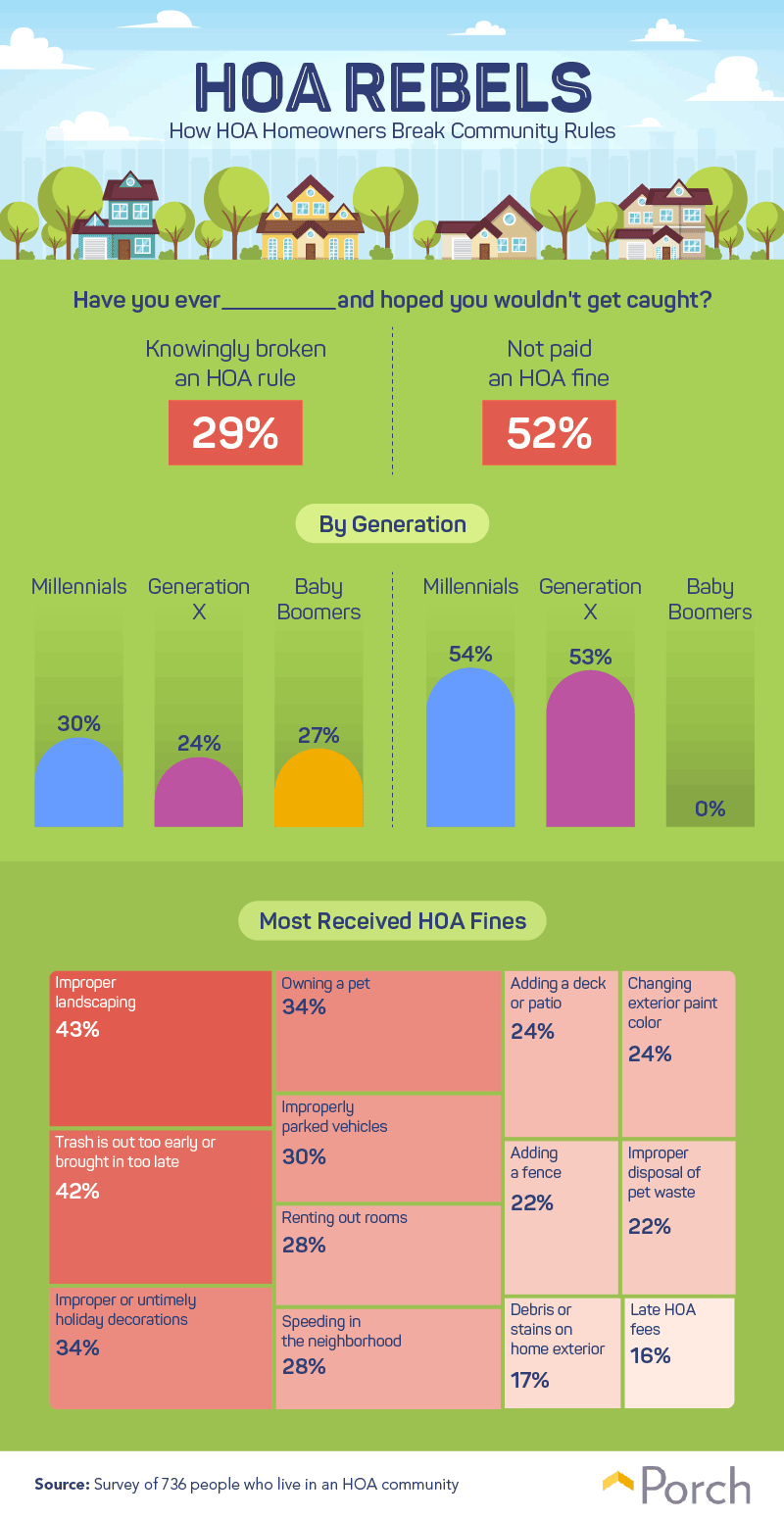 If rules are meant to be broken, HOA regulations are certainly no exception. Nearly one-third of people said they had broken one of their association’s rules and hoped they wouldn’t get caught, while more than half had neglected to pay an HOA fine hoping nobody would notice. There was practically no difference between the generations regarding who committed these tiny transgressions, with one exception: None of the baby boomers surveyed said they skipped out on paying an HOA fine. Fines can be given out for any number of reasons, but the most common ones were improper landscaping (43 percent) and disposing of trash at the wrong time (42 percent). People also got ticketed for holding onto their holiday decorations for too long or putting them out too early (34 percent) or smuggling in a pet (34 percent). If you ever find an HOA fine inside your mailbox, it’s important to know your rights as a resident. For example, your association can only ticket you for infractions that are explicitly stated in the community conditions and restrictions: You typically have the right to appeal the fine if it violates this guideline.
If rules are meant to be broken, HOA regulations are certainly no exception. Nearly one-third of people said they had broken one of their association’s rules and hoped they wouldn’t get caught, while more than half had neglected to pay an HOA fine hoping nobody would notice. There was practically no difference between the generations regarding who committed these tiny transgressions, with one exception: None of the baby boomers surveyed said they skipped out on paying an HOA fine. Fines can be given out for any number of reasons, but the most common ones were improper landscaping (43 percent) and disposing of trash at the wrong time (42 percent). People also got ticketed for holding onto their holiday decorations for too long or putting them out too early (34 percent) or smuggling in a pet (34 percent). If you ever find an HOA fine inside your mailbox, it’s important to know your rights as a resident. For example, your association can only ticket you for infractions that are explicitly stated in the community conditions and restrictions: You typically have the right to appeal the fine if it violates this guideline.
Who’s helping whom?
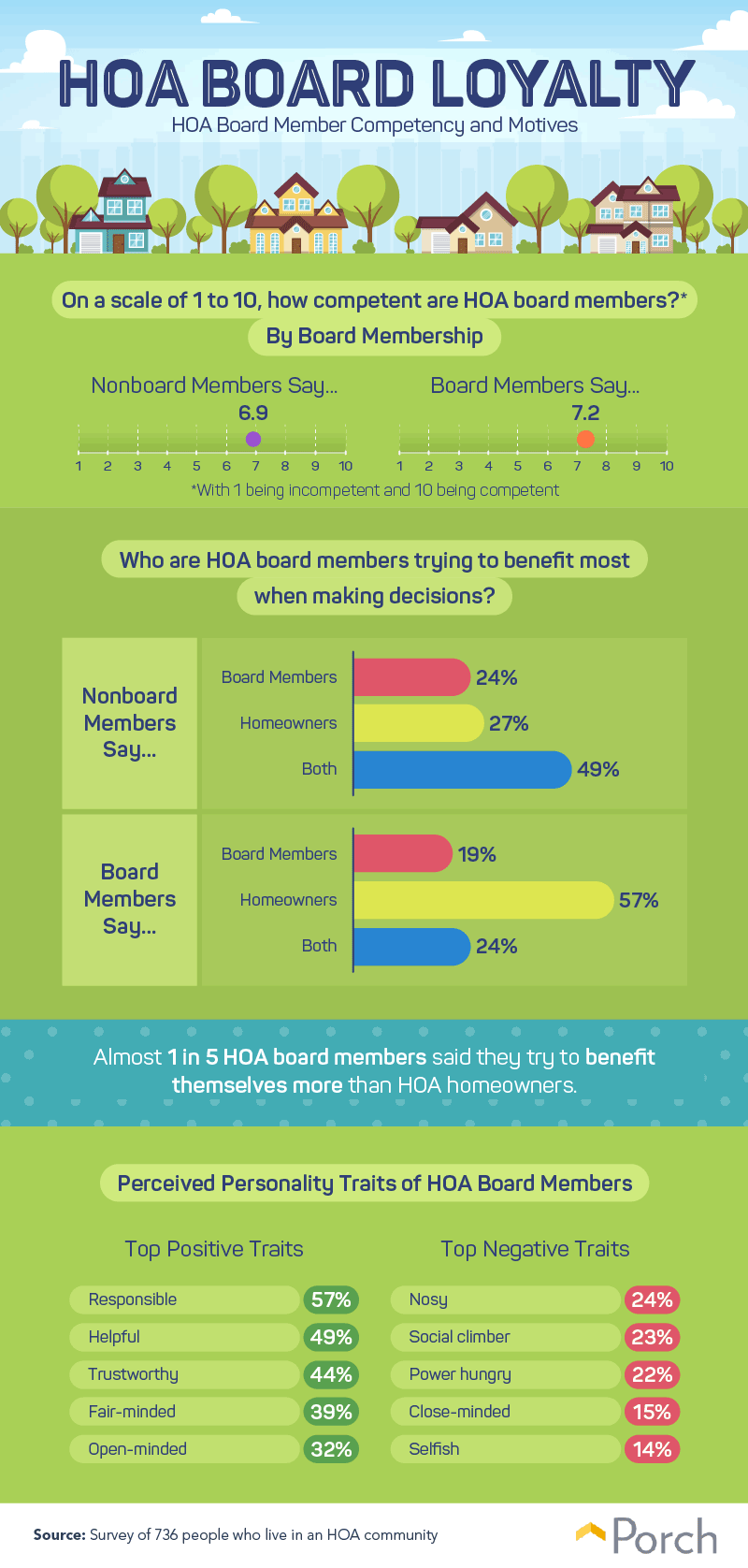 Interestingly enough, when it came to competence, there was barely any difference between residents’ opinions of their HOA board members and those same board members’ self-evaluations. Members did rank themselves slightly higher on the competence scale, but not by much. However, the nuances between these two groups began to reveal themselves with whom the HOA intended to serve with their decisions. Nearly half of nonboard members said they thought their HOA tried to benefit both the residents and board, with the remaining half split almost equally between homeowners and board members (27 and 24 percent, respectively). On the other hand, people on the inside were much more likely to label their efforts as entirely homeowner-centric at 57 percent—although there is very likely some bias baked into that number since the HOA is self-reporting their own interests. A surprisingly high 19 percent of board members said they worked to benefit themselves, and 24 percent said there was a bit of both. If you feel the scales are indeed tipped against you as a homeowner, here’s how to file an effective claim against your association to protect your interests and rights.
Interestingly enough, when it came to competence, there was barely any difference between residents’ opinions of their HOA board members and those same board members’ self-evaluations. Members did rank themselves slightly higher on the competence scale, but not by much. However, the nuances between these two groups began to reveal themselves with whom the HOA intended to serve with their decisions. Nearly half of nonboard members said they thought their HOA tried to benefit both the residents and board, with the remaining half split almost equally between homeowners and board members (27 and 24 percent, respectively). On the other hand, people on the inside were much more likely to label their efforts as entirely homeowner-centric at 57 percent—although there is very likely some bias baked into that number since the HOA is self-reporting their own interests. A surprisingly high 19 percent of board members said they worked to benefit themselves, and 24 percent said there was a bit of both. If you feel the scales are indeed tipped against you as a homeowner, here’s how to file an effective claim against your association to protect your interests and rights.
Management styles
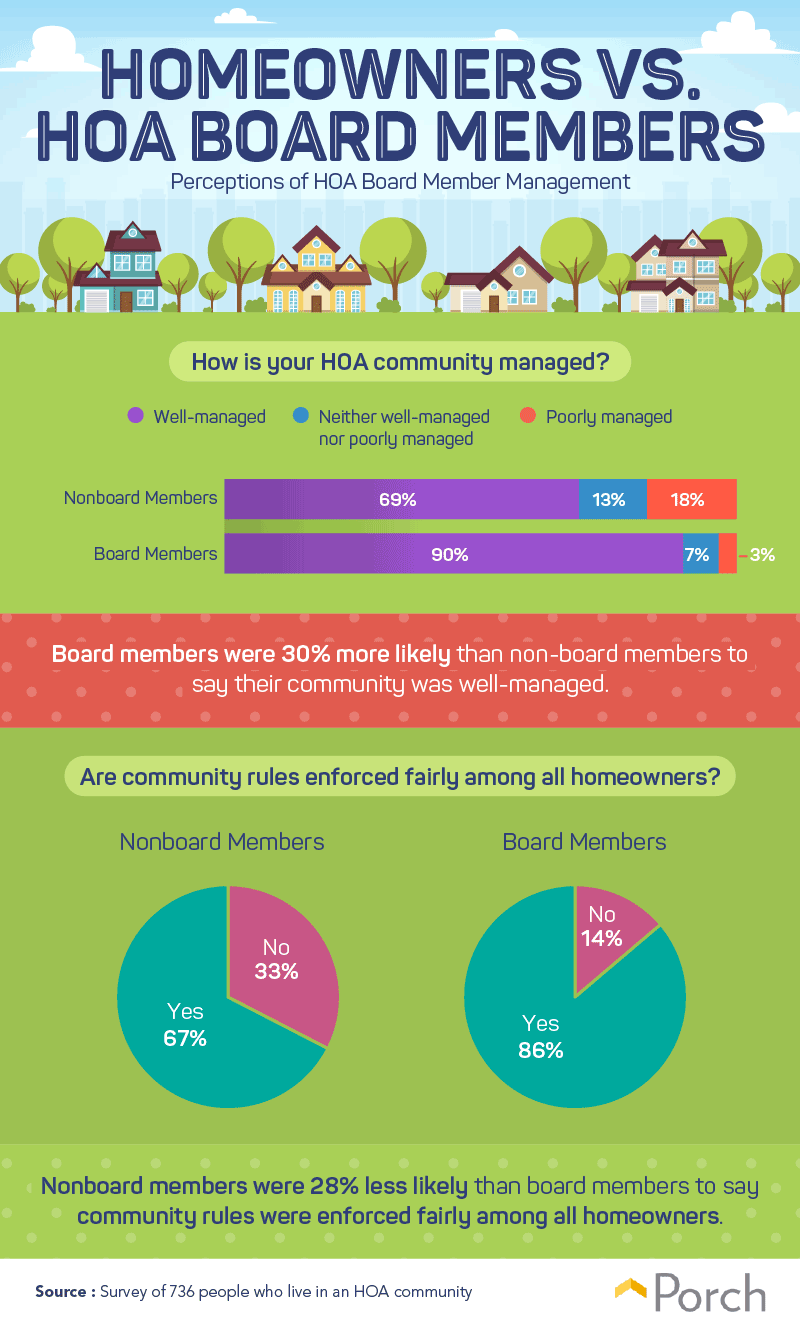 If you’re not careful, you could unknowingly commit a violation that puts you on your HOA’s naughty list. Nit-picky rules are often at the heart of HOA-homeowner tensions, which can make residents feel like they’re perpetually under someone’s thumb. That being said, the majority of nonboard members (69 percent) said they were actually quite satisfied with the way their HOA managed their community, and only 18 percent felt the board was doing a poor job. Board members, on the other hand, reported a cool 90 percent satisfaction rate regarding the quality of their community management. Board members were also far more likely to feel as though community rules were enforced in a fair and equitable manner at 86 percent. Homeowners felt a little less optimistic at just 67 percent.
If you’re not careful, you could unknowingly commit a violation that puts you on your HOA’s naughty list. Nit-picky rules are often at the heart of HOA-homeowner tensions, which can make residents feel like they’re perpetually under someone’s thumb. That being said, the majority of nonboard members (69 percent) said they were actually quite satisfied with the way their HOA managed their community, and only 18 percent felt the board was doing a poor job. Board members, on the other hand, reported a cool 90 percent satisfaction rate regarding the quality of their community management. Board members were also far more likely to feel as though community rules were enforced in a fair and equitable manner at 86 percent. Homeowners felt a little less optimistic at just 67 percent.
Fussing about fees
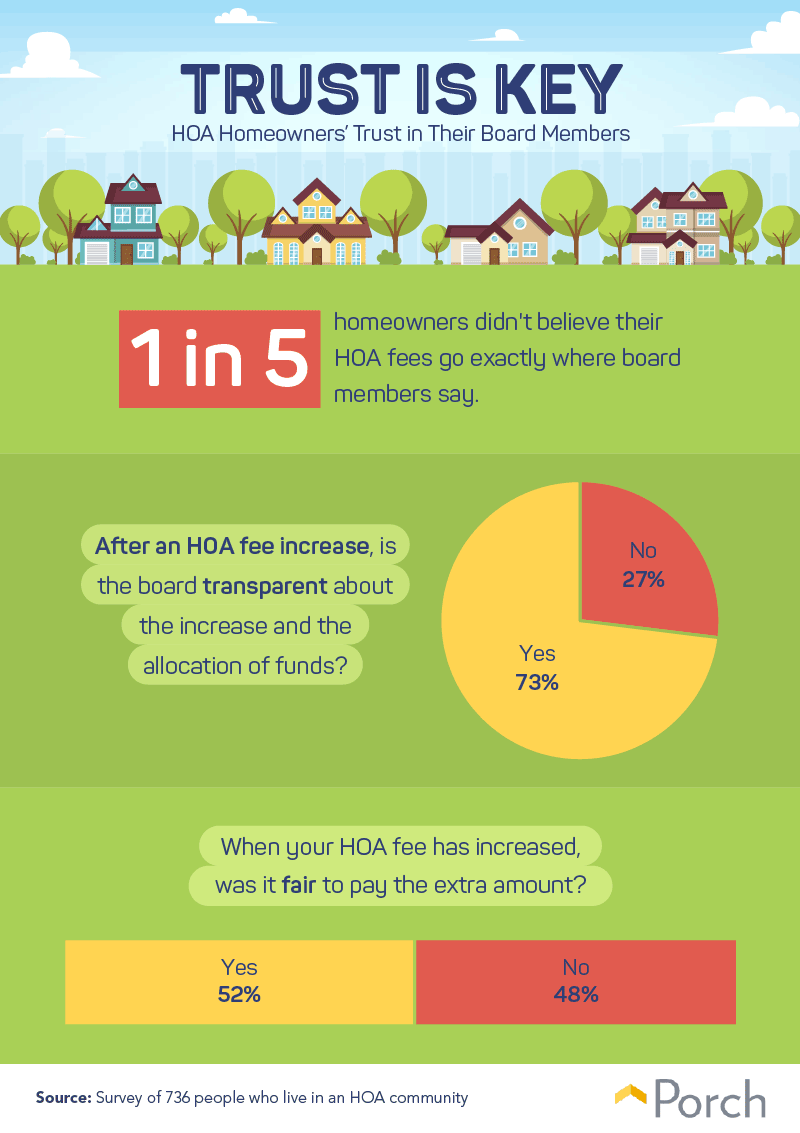 Our respondents expressed some suspicion about how their monthly HOA fees were really spent: 1 in 5 community members said they weren’t convinced their money was spent on what their community managers claimed. They were, however, more confident in the board’s honesty when it came to fee increases. Nearly three-quarters felt their HOA was transparent about the reasons behind fee hikes—although that transparency didn’t stop 48 percent of respondents from feeling it wasn’t fair they had to pay more in the first place. Understanding how HOA fee increases work is a must for anyone living in this type of community. If you’re starting to feel like your dues are seemingly always going up, it’s important to know if your board’s actions are within bounds or not entirely fair.
Our respondents expressed some suspicion about how their monthly HOA fees were really spent: 1 in 5 community members said they weren’t convinced their money was spent on what their community managers claimed. They were, however, more confident in the board’s honesty when it came to fee increases. Nearly three-quarters felt their HOA was transparent about the reasons behind fee hikes—although that transparency didn’t stop 48 percent of respondents from feeling it wasn’t fair they had to pay more in the first place. Understanding how HOA fee increases work is a must for anyone living in this type of community. If you’re starting to feel like your dues are seemingly always going up, it’s important to know if your board’s actions are within bounds or not entirely fair.
Doing your part to maintain your home
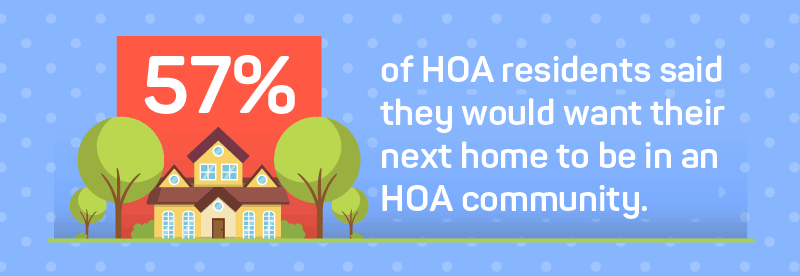 Pros and cons of HOAs aside, the majority of our respondents wound up living in this type of community by coincidence as opposed to preference. Primarily drawn in by the property itself and not necessarily the amenities, most people believed they paid too high of a monthly fee for what they got, and less than a third used any given amenity at least once a month. Residents generally held their HOA board in high esteem when it came to competence and having their best interests in mind, but board members were always a little more generous with themselves when it came time to rank their abilities and interests. While your HOA is in charge of landscaping and general maintenance, most home fixes are still your responsibility. Porch is the best way to find top-rated local maintenance, repair, and renovation specialists, from fencing and flooring to plumbing and roofing. Visit Porch to find a vetted, qualified home improvement contractor in your area and get the job done right.
Pros and cons of HOAs aside, the majority of our respondents wound up living in this type of community by coincidence as opposed to preference. Primarily drawn in by the property itself and not necessarily the amenities, most people believed they paid too high of a monthly fee for what they got, and less than a third used any given amenity at least once a month. Residents generally held their HOA board in high esteem when it came to competence and having their best interests in mind, but board members were always a little more generous with themselves when it came time to rank their abilities and interests. While your HOA is in charge of landscaping and general maintenance, most home fixes are still your responsibility. Porch is the best way to find top-rated local maintenance, repair, and renovation specialists, from fencing and flooring to plumbing and roofing. Visit Porch to find a vetted, qualified home improvement contractor in your area and get the job done right.
Methodology and limitations
We used Amazon’s Mechanical Turk to survey 736 people who currently live in an HOA community. Seventy-nine percent were homeowners; 13 percent had been on the HOA board in the past but were not currently; and 8 percent were HOA board members. Fifty-one percent of respondents were men; 49 percent were women; and less than 1 percent identified with a nonbinary gender. Fifty-seven percent of respondents were millennials (born 1981 to 1997); 28 percent were from Generation X (born 1965 to 1980); 12 percent were baby boomers (born 1946 to 1964); 2 percent were from Generation Z (born 1928 to 1943); 1 percent was from the silent generation (born 1928 to 1945); and less than 1 percent was from the greatest generation (born 1927 or earlier). The average age of respondents was 38 with a standard deviation of 12 years. To be considered in our data, respondents were required to a) complete all survey questions and b) pass an attention-check question in the middle of the survey. Participants who failed to do either of these were excluded from the study. We created scales of 1 to 10, with 1 being the lowest measure and 10 being the highest measure, for respondents to rate the competency of HOA board members. Results were then averaged. Outliers were excluded from any calculations using quantitative values, including HOA fees and HOA board member ages. “Nonboard members” includes those who have never been on an HOA board, while “board members” includes those who were on an HOA board at the time of the survey.
Fair use statement
This study lives here, but we would be more than happy for you to pass it around for noncommercial purposes. All we ask is that you link back to the original piece so that credit is given where it’s due, and your network can get all the facts.
